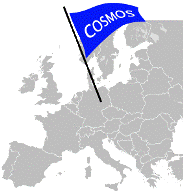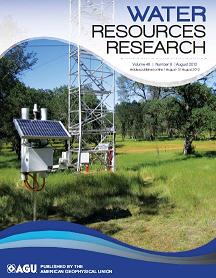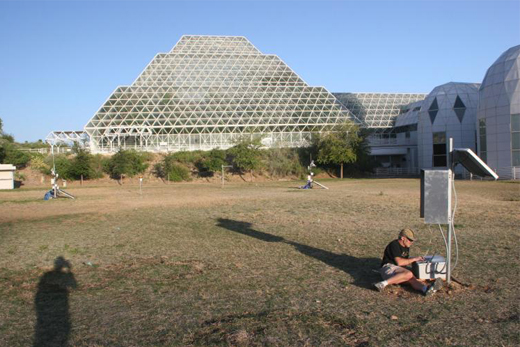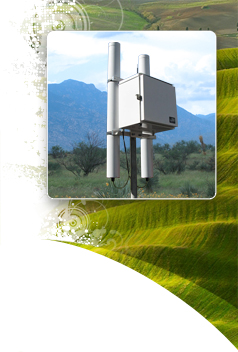Come see Hydroinnova at AGU in New Orleans
2017 Fall Meeting, Dec 11-15, Booth 419

Leipzig at the center of the COSMOS
Helmholtz-UFZ to host 4th soil moisture workshop, May 5-8

April 15, 2014 - Albuquerque, NM
Hydroinnova News click for more...
Trenton presents...
A CUAHSI cyberseminar by Dr. Trenton Franz of the University of Arizona covering the theory and application of the cosmic-ray neutron probe
March 29, 2013 - Tucson, AZ
Click for YouTube video...
2013 Robert E. Horton lecture delivered by COSMOS co-PI Shuttleworth
January 9, 2013 - Austin, TX
Hydroinnova News click for more...
Hydroinnova's cosmic-ray moisture probe graces cover of top-ranked journal
September 24, 2012 - Albuquerque, NM
Hydroinnova News click for more...

3rd COSMOS workshop draws international crowd
December 12, 2012 - Tucson, AZ
Hydroinnova News click for more..
Hydroinnova's cosmic-ray moisture probe graces cover of top-ranked journal
September 24, 2012 - Albuquerque, NM
Hydroinnova News click for more...

The emergence of terrestrial hydrometeorology: COSMOS CO-PI and University of Arizona Professor Jim Shuttleworth delivers Langbein Lecture at AGU
December, 2011 - San Francisco
American Geophysical Union, Fall Meeting click for video...
Preliminary results show COSMOS provides reliable method for area average continental-scale soil moisture data
August, 2011
GEWEX News click for pdf...
Cosmic-rays, deep drills, moisture movement
May, 2011 - Central West Australia
Agriculture Today click for more...
Cosmic-rays detect soil moisture
November, 2010 - Tucson, AZ
US News and World Report click for more...
Hydroinnova founder shares Fourth Annual Prince Sultan Bin Abdulaziz International Prize for Water
October, 2010 - Riyadh
PSIPW web page click for more...
The contraption is just a dirt moisture detector. Honest.
March, 2009
Symmetry Magazine click for more...
UA scientists' project could revolutionize meteorlogy
October, 2009 - Tucson, AZ
Arizona Daily Star click for more...
University of Arizona team awarded $5.45M for network to improve weather forecasting
September, 2009 - Tucson, AZ
UA News click for more...
Hydroinnova completes installation at Biosphere2 for pilot soil moisture network
May 1, 2008 - Tucson, AZ
Hydroinnova News click for more...
Scientist Water Equivalent measured with cosmic rays at 2006 AGU meeting
December, 2007 - San Francisco
Weather Underground click for more...
Leipzig at the center of the COSMOS:
Helmholtz-UFZ to host 4th soil moisture workshop,
May 5-8
[ April 15, 2014 - Leipzig, Germany ]
Scientists from around the world will gather this year in Leipzig to discuss cutting-edge research in soil moisture observations.
Scheduled to take place on the tail of EGU General Assembly meeting in Vienna, the workshop will include reports on rapidly expanding networks in Germany, the UK and South Africa, as well as established networks in the US and Australia.
Topics include:
* Calibration and validation
* Biomass
* Ecosystem states and fluxes
* Neutron transport and detection
A field trip is planned to UFZ's Schäfertal catchment and Bad Lauchstädt site.
For more information: http://www.ufz.de/cosmos/
2013 Robert E. Horton lecture delivered by COSMOS co-PI Shuttleworth
[ January 9, 2013 - Austin, TX ]
COSMOS co-PI and University of Arizona professor Jim Shuttleworth adds to his lengthy record of distinguished talks by delivering the venerable Robert E. Horton Lecture. His talk, titled "In the Next Decade We Will Mine the Meteorological Predictability Associated with Measured Storage of Atmospherically Accessible Water on Land Surfaces" describes the crucial role that land-surface water plays in atmospheric processes, and highlights the importance of Hydroinnova's cosmic-ray soil moisture monitoring technology as a key observational tool.
The lecture was delivered at the annual meeting of the American Meteorological Society (AMS) held in Austin, TX. AMS is a 14,000 member organization influential in atmospheric, oceanic and hydrologic sciences.
The Robert E. Horton Lecture was established to recognize an eminent scientist's significant contributions to the understanding of activities that support the integration of expertise in the hydrological and meteorological sciences. The purpose of the lectureship is to encourage and foster an interchange of ideas between meteorologists and hydrologists.
Prior awardees include Dara Entekhabi, James A. Smith, and John C. Schaake.
3rd COSMOS workshop draws international crowd
[ December 10-12, 2012 - Tucson, AZ ]
In an effort to forge a global community of cosmic-ray probe researchers, the University of Arizona hosted the 3rd COSMOS Workshop at the Ventana Canyon Resort in Tucson. COSMOS is an acronym for the COsmic ray Soil Moisture Observing System, a national network of soil moisture sensors sponsored by the US National Science Foundation.
At the meeting Hydroinnova scientist Darin Desilets reviewed the fundamentals of the technique, described exciting new possibilities in the area of canopy-intercepted water, and updated participants on the state of the art of the technology. Others discussed the role of in situ soil moisture observations in ecological networks, hydrologic forecasting, and satellite remote sensing calibration and validation.
Participants represented universities and government agencies from the US, Australia, Denmark, Germany, France, Italy and Mexico.
Hydroinnova's cosmic-ray moisture probe graces cover of top-ranked journal
[ September 24, 2012 - Albuquerque, NM ]
A cosmic-ray soil moisture probe at Tonzi Ranch, CA is featured on the cover of the latest edition of Water Resources Research, the top-ranked journal in water science and technology.
The model shown here is a two-channel CRS-1000/B, installed by Trenton Franz of the  University of Arizona. This unit is one of nearly sixty probes forming the US National Science Foundation's nascent COsmic-ray Soil Moisture Observing System (COSMOS) (http://cosmos.hwr.arizona.edu/). Soil moisture measurements with the CRS-1000/B will support ecological research at the Tonzi Ranch Ameriflux site, an oak savanna site maintained by scientists at UC-Berkley.
University of Arizona. This unit is one of nearly sixty probes forming the US National Science Foundation's nascent COsmic-ray Soil Moisture Observing System (COSMOS) (http://cosmos.hwr.arizona.edu/). Soil moisture measurements with the CRS-1000/B will support ecological research at the Tonzi Ranch Ameriflux site, an oak savanna site maintained by scientists at UC-Berkley.
The Ameriflux eddy covariance tower, shown in the background, collects data on the fluxes of heat, water and carbon dioxide. The wide footprint for the cosmic-ray probe roughly matches that of the eddy covariance tower, providing appropriately scaled measurements. This represents a major advance over the conventional approach of using a small number of point soil moisture measurements to support the large footprint of the flux tower. For this reason many of the other COSMOS probes are also co-located at eddy covariance towers.
The article by Franz discusses the depth weighting function for the cosmic-ray probe and can be found here: http://www.agu.org/pubs/crossref/2012/2012WR011871.shtml.
Full citation and abstract:
, M. Zreda, T. P. A. Ferre, R. Rosolem, C. Zweck, S. Stillman, X. Zeng, and W. J. Shuttleworth (2012), Measurement depth of the cosmic ray soil moisture probe affected by hydrogen from various sources, Water Resources Research, 48, 8, doi: 10.1029/2012WR011871.
Abstract:
We present here a simple and robust framework for quantifying the effective sensor depth of cosmic ray soil moisture neutron probes such that reliable water fluxes may be computed from a time series of cosmic ray soil moisture. In particular, we describe how the neutron signal depends on three near-surface hydrogen sources: surface water, soil moisture, and lattice water (water in minerals present in soil solids) and also their vertical variations. Through a combined modeling study of one-dimensional water flow in soil and neutron transport in the atmosphere and subsurface, we compare average water content between the simulated soil moisture profiles and the universal calibration equation which is used to estimate water content from neutron counts. By using a linear sensitivity weighting function, we find that during evaporation and drainage periods the RMSE of the two average water contents is 0.0070 m3 m−3 with a maximum deviation of 0.010 m3 m−3 for a range of soil types. During infiltration, the RMSE is 0.011 m3 m−3 with a maximum deviation of 0.020 m3 m−3, where piston like flow conditions exists for the homogeneous isotropic media. Because piston flow is unlikely during natural conditions at the horizontal scale of hundreds of meters that is measured by the cosmic ray probe, this modeled deviation of 0.020 m3 m−3 represents the worst case scenario for cosmic ray sensing of soil moisture. Comparison of cosmic ray soil moisture data and a distributed sensor soil moisture network in Southern Arizona indicates an RMSE of 0.011 m3 m−3 over a 6 month study period.
Hydroinnova completes installation at Biosphere2 for pilot soil moisture network
[ May 1, 2008 - Tucson, AZ ]
Hydroinnova completes installation of the COsmic-ray Soil Moisture Observing System (COSMOS) pilot network for researchers at the University of Arizona. The network, comprising three cosmic-ray sensor nodes with automated logging and cell phone data retrieval, was installed just in time for a University of Arizona sponsored workshop being held in Tucson AZ.
A selection of prominent atmospheric scientists, hydrologists and remote sensing experts from government and academia were invited to the workshop along with industry representatives. Discussions focused on data assimilation issues, deployment plans and coordination with existing observational networks and programs. With continued support, it is hoped that by the year 2013 the pilot COSMOS network will be expanded to continental scale coverage.









